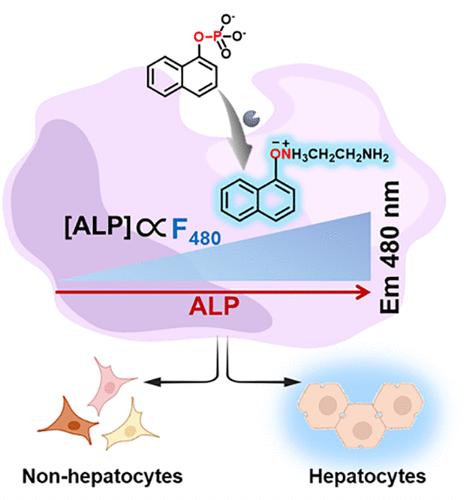从血清到器官:胺-萘模块化平台能够精确鉴定和定量碱性磷酸酶
IF 6.7
1区 化学
Q1 CHEMISTRY, ANALYTICAL
引用次数: 0
摘要
碱性磷酸酶(ALP)的准确检测对于临床诊断和不同组织的机制研究至关重要。在这里,我们提出了一个基于1-萘酚磷酸钠(1-NPP)和乙二胺(EDA)的模块化“开关”荧光探针平台,能够精确、快速、经济地定量从血清到整个器官的ALP活性。探针的机制依赖于alp催化的1-NPP水解释放1-萘酚,萘酚随后与EDA反应产生强大的荧光信号。该系统灵敏度高,检出限为0.068 mU/mL,在包括血清、细胞裂解液和组织匀浆在内的复杂生物基质中保持良好的线性和稳定性。在各种细胞系和小鼠器官中的应用揭示了器官和疾病特异性ALP活性分布,突出了其在区分生理和病理状态方面的应用。与基于纳米粒子的传感器相比,探针的低细胞毒性和简单的制备提供了显著的优势。总的来说,这项工作为ALP分析建立了一个多功能和可扩展的平台,其区分细胞和器官间ALP活性的卓越能力支撑了其在早期疾病监测、机制探索和高通量筛选方面的广泛潜力。本文章由计算机程序翻译,如有差异,请以英文原文为准。

From Serum to Organ: The Amine-Naphthalene Modular Platform Enables Precise Identification and Quantification of Alkaline Phosphatase
Accurate detection of alkaline phosphatase (ALP) is critical for clinical diagnosis and mechanistic studies across diverse tissues. Here, we present a modular “off-on” fluorescent probe platform based on 1-naphthol phosphate sodium (1-NPP) and ethylenediamine (EDA), enabling precise, rapid, and cost-effective quantification of ALP activity from serum to whole organs. The probe’s mechanism relies on the ALP-catalyzed hydrolysis of 1-NPP to liberate 1-naphthol, which subsequently reacts with EDA to generate a robust fluorescent signal. This system demonstrates high sensitivity, with a detection limit of 0.068 mU/mL, and maintains excellent linearity and stability across complex biological matrices including serum, cell lysates, and tissue homogenates. Application in various cell lines and mice organs revealed organ- and disease-specific ALP activity distributions, highlighting its utility for distinguishing physiological and pathological states. The probe’s low cytotoxicity and straightforward preparation offer significant advantages over nanoparticle-based sensors. Overall, this work establishes a versatile and scalable platform for ALP analysis, whose remarkable ability to distinguish ALP activity across cells and organs underpins its broad potential for early disease surveillance, mechanistic exploration, and high-throughput screening.
求助全文
通过发布文献求助,成功后即可免费获取论文全文。
去求助
来源期刊

Analytical Chemistry
化学-分析化学
CiteScore
12.10
自引率
12.20%
发文量
1949
审稿时长
1.4 months
期刊介绍:
Analytical Chemistry, a peer-reviewed research journal, focuses on disseminating new and original knowledge across all branches of analytical chemistry. Fundamental articles may explore general principles of chemical measurement science and need not directly address existing or potential analytical methodology. They can be entirely theoretical or report experimental results. Contributions may cover various phases of analytical operations, including sampling, bioanalysis, electrochemistry, mass spectrometry, microscale and nanoscale systems, environmental analysis, separations, spectroscopy, chemical reactions and selectivity, instrumentation, imaging, surface analysis, and data processing. Papers discussing known analytical methods should present a significant, original application of the method, a notable improvement, or results on an important analyte.
 求助内容:
求助内容: 应助结果提醒方式:
应助结果提醒方式:


